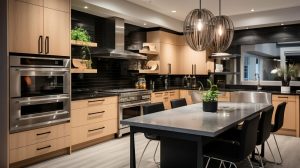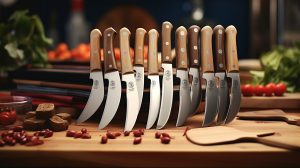Can you install pull-out drawers in your kitchen cabinets? Absolutely! Adding pull-out drawers is one of the best ways to upgrade your kitchen cabinets. With just a few tools and DIY know-how, you can complete a cabinet retrofit to maximize your storage space and accessibility.

There are several benefits to installing pull-out organizers in your cabinets:
- Maximize cabinet space – Pull-outs allow you to access all cabinet areas, not just the front.
- Improve accessibility – No more crouching down or reaching the back of cabinets. Everything is brought to you.
- Make better use of base cabinets and under-cabinet areas.
- Upgrade functionality – Installing pull-outs can make cabinets more efficient and tailored to your storage needs.
You have options when it comes to pull-out solutions:
- Pull-out drawers – Enclosed drawers with sides, bottom and back. Sturdiest option.
- Rollout shelves – Open trays that slide out. Suitable for some content.
- Pull-out organizers – Specialty organizers designed for specific items like pots, pans or spices.
In this blog post we will walk through planning, installing, and using DIY cabinet drawers to improve kitchen storage solutions.
Benefits of Pull-Out Drawer Retrofits
Installing pull-out organizers in your kitchen cabinets can transform your storage efficiency and accessibility. Here are some of the top benefits of completing a drawer retrofit project:
Maximize Cabinet Storage Space
- Traditional base cabinets with fixed shelves often need more space. Items get buried in the back while the front of the frame remains empty.
- Pull-out drawers allow you to access 100% of your cabinet space since the drawer rolls out fully.
- You can optimize every inch of space by storing items front to back. No more wasted space!
Improve Accessibility
- Reaching the back of standard base cabinets requires bending down or climbing on counters. This can be difficult for those with back issues or mobility challenges.
- Pull-out organizers roll out smoothly to eliminate reaching. Bring everything to you at the waist or counter height.
- For those with disabilities or limited mobility, pull-outs can make kitchen tasks much more manageable.
Upgrade Cabinet Functionality
- Standard cabinets with fixed shelves need to be customizable. With pull-out drawers, you can design each cabinet according to your needs.
- Optimize kitchen storage solutions by adding specialized pull-outs: Pantry cabinet with divided drawers for food storage.
- Deep drawer for pots and pans
- Spice organizer
- Tray divider for cutting boards and baking sheets
- Drawer optimized for containers.
- Improve ergonomics by putting the most-used items in the most convenient pull-out locations.
Make the Most of Wasted Spaces
- Under-cabinet and base cabinet areas often need to be more utilized.
- Use pull-outs to add storage to toe-kick areas, bathroom vanities, media cabinets, etc.
- Optimize narrow spaces with vertical pull-out organizers.
DIY or Buy Pull-Outs
- Purchased pull-outs are available in many sizes and designs. Choose one that fits your cabinet space and storage needs.
- Building your DIY cabinet drawers allows full customization—design for precisely what you want to store.
- Mix and match! Buy a speciality pull-out for one cabinet, and build your own for another.
Elevate Kitchen Style
- Pull-outs give a high-end, custom feel to ordinary builder-grade cabinets.
- Wood rollouts add warmth and blend seamlessly. Stainless steel gives a sleek, modern look.
- Open shelves keep everything visible. Enclosed drawers hide clutter for a tidier appearance.
- Add touches like cabinet labels, knobs, and under-cabinet lighting.
You can transform your kitchen’s form and function with simple tools, DIY know-how, and a weekend. Investing in pull-outs is worth the effort for space maximization, ease of access, and customization.
Types of Pull-Out Storage Solutions
When tackling a kitchen cabinet makeover, you’ll need to decide which type of pull-out organizers you want to install. Consider how you plan to use each cabinet and choose the pull-out that best suits your storage needs.
Pull-Out Drawers
- Fully enclosed drawer with sides, bottom and back panel
- A most versatile option that can hold a wide variety of items
- Sides help corral loose items and keep stacks upright
- Size drawers to fit your cabinet dimensions
- Can be built custom or purchased pre-made
Best Uses:
- Pantry storage – foods, snacks
- Dishes and platters
- Pots and pans
- Baking sheets and cutting boards
- Kitchen tools and gadgets
- Spices and dry goods
- Towels and linens
Rollout Shelves
- Open trays that slide out like a drawer without sides
- Allows for easy access and view of contents
- Best for items that won’t roll around
- Available with edge lips to corral small items
Best Uses:
- Canned goods and jarred foods
- Spices and dry ingredients
- Cleaning supplies and household items
- Bathroom towels, toiletries and cosmetics
Pull-Out Organizers
- Custom-designed pull-outs made for specific items
- Optimize storage and access for plates, pots, pans, spices, etc.
- Shop or DIY organizers tailored to your storage needs
Types of Organizers:
- Plate and platter racks
- Pots and pan organizers
- Spice drawer organizers
- Tiered storage for baking sheets, cutting boards, trays
- Full-height pantry pull-outs
- Drawer divider kits
Get creative and look for pull-outs like vertical rack storage or under-sink cabinet rollouts to maximize every inch. Take advantage of that wasted toe-kick space!
Consider Ergonomics
- Make the contents easy to view without bending down or reaching up high.
- Place the heaviest items in lower cabinets and drawers.
- Put the most frequently used items in the most convenient spots.
Take some time to think through your cabinet contents and usage to determine the best pull-out solutions for each area. Mix and match rollouts for maximum efficiency.
Where to Install Pull-Outs
When revamping your kitchen, consider all the different cabinet areas that could benefit from pull-out drawers or shelves.
Base Cabinets
The base cabinet area is prime real estate for pull-out drawer conversion. This area gets used constantly for food storage and prep.
- Eliminates awkward bending down to reach contents.
- Allows full access to the back of the cabinet.
- Customize drawers for plates, pans, appliances, etc.
Considerations:
- Measure drawer size carefully to fit in the cabinet.
- Account for hinges, doors, and face frames.
- Put the heaviest items in lower drawers.
Under-Cabinet Spaces
Often overlooked, under-cabinet areas are ideal for pull-out storage.
- Use rollouts in toe-kick space.
- Great for trays, cutting boards, and pans.
- Optimize the area under the kitchen sink.
- Create two-tiered pull-outs to maximize space.
Things to check:
- Ensure pull-outs clear plumbing and garbage disposals.
- Measure around existing under-cabinet appliances.
- Allow room for doors and drawers to open.
Pantry Cabinets
Transform an ordinary pantry into a super-functional storage space.
- Use deep drawers for bulk foods and snacks.
- Incorporate narrow vertical spaces.
- DIY rollouts to fit oddly sized areas.
- Label drawers for easy organization.
Tips for pull-out pantries:
- Use drawer divider kits to optimize storage.
- Put everyday items in easy-access spots.
- Maximize vertical space with tall and stacked pull-outs.
Other Areas
Get creative with cabinet pull-outs throughout the home:
- Bathroom vanities and cabinets
- Media centres and TV stands
- Mudroom lockers
- Craft cabinets and hobby spaces
- Laundry room cabinets
- Bedroom closets
Anywhere you find yourself digging around stacked items, cabinet pull-outs can help eliminate the mess and hassle!
How to Install Pull-Out Drawers
You can tackle installing pull-out organizers in your kitchen cabinets with a few tools and DIY skills. Follow these general steps:
Cabinet Measurement
- Remove existing shelves and contents.
- Measure interior cabinet dimensions: height, width, and depth.
- Note any obstructions – pipes, supports, hinges.
- Account for face frames when taking measurements.
- Determine if you want to keep/remove existing shelves.
Install Drawer Slides
- Choose slide type: roller, ball-bearing, or wood.
- Use a template or measure per instructions to position slides.
- Attach slides securely by pre-drilling and screwing them into the cabinet.
- Use shims if needed to clear face frames or level slides.
- Test slides for smooth operation before proceeding.
Build or Buy Drawer Boxes
Option 1 – Buy Pre-Made:
- Order drawer boxes in the correct dimensions for your cabinet.
- Assemble the pull-out according to instructions.
- Attach to drawer slides and install in cabinet.
Option 2 – Build Custom:
- Cut wood pieces to size per your measurements.
- Assemble the drawer box using joints and wood glue.
- Attach drawer slides according to instructions.
- Sand and finish the drawer box with stain/paint.
- Install the finished drawer by attaching it to cabinet slides.
Tips for Installation
- Work slowly and double-check measurements.
- Use a “story stick” to note all measurements in one place.
- Have someone help support heavy drawers during installation.
- Test operation and make adjustments as needed.
- Use shims if the drawer is too narrow for cabinet opening.
Take your time, and don’t get frustrated! Getting everything aligned and operating smoothly may take some trial and error.
Tips for Custom Pull-Out Drawers
If creating DIY custom pull-outs, keep these tips in mind:
Design and Size for Intended Contents
- Take measurements of the items you plan to store, including Plates, pots, pans, containers
- Food packages, jars, cans
- Appliances, gadgets
- Spice jars, baking supplies
- Allow for some growth if adding new dishes or appliances.
- Incorporate vertical dividers and tiered storage as needed.
Choose Durable Materials
Popular cabinet pull-out materials:
- Wood: Attractive material that stains well to match cabinets. Avoid thin plies. Plywood – birch, maple
- Solid wood – poplar, pine
- Stainless steel: Sleek and modern looking. Sturdy but light. Wire rack allows visibility.
- Plastic: Affordable but less durable for heavy contents. Best for lightweight pull-out trays.
- Metal: Heavy-duty material conducts temperature. Painted finishes are available.
Consider durability, weight capacity, and moisture resistance based on drawer contents.
Add Dividers and Organizers
- Incorporate vertical dividers in drawers to keep items separated.
- Use tray organizers to corral small jars, bottles, etc.
- Add adjustable shelves to make levels for small and oversized items.
- Use drawer inserts for utensils, cutting boards, spices, etc.
Enhance Visibility
- Opt for open tray-style shelves for easy viewing.
- Use wire racks or slotted designs for see-through drawers.
- Add undercabinet lighting to illuminate the interior.
- Consider glass cabinet doors for an open concept.
Plan for Drawer Weight
- Calculate the weight of contents and choose sufficiently rated drawer slides.
- Put heavier contents in bottom drawers.
- Install the heaviest items towards the back of the drawer.
- Use sturdy materials like wood and steel for rich content.
Custom sizing and building pull-outs allow you to tailor your kitchen cabinets to your needs for optimal efficiency. Get creative with your cabinet makeover!
Avoid Installation Obstacles
When taking on a kitchen cabinet makeover, there are a few obstacles to look out for to ensure your pull-outs function properly:
Watch for Hinges and Doors
- Cabinet hinges and doors can collide with slide-out shelves if not positioned correctly.
- When taking measurements, open cabinet doors fully to see how much they overlap the cabinet opening.
- Account for hinge locations – will slides clear hinges when pulled out?
- You may need to install drawer slides further back if doors or hinges protrude too far.
Account for Face Frames
- Face frame cabinets make the inside dimensions smaller than the outer frame.
- Measure the inside width carefully when building pull-out drawer boxes.
- Boxes must slide smoothly past the face frame.
- Use wood shims under slides to raise and clear the face frame lip.
Get Proper Drawer Slide Extension
For full cabinet access, choose:
- Full extension slides to allow the drawer to open fully.
- Overextension to open drawer past cabinet depth.
Avoid:
- Partial extension slides that don’t pull out enough.
- Under extension with very limited clearance.
Measure your cabinet depth and get slides rated for full or overextension.
Clear Plumbing and Electrical
- Check for plumbing pipes, drains, and wires that protrude.
- Especially important under kitchen sink base cabinets.
- We may need to alter drawer dimensions for clearance.
- You can also notch wood drawer boxes around obstructions.
Mind the Cabinet Base
- Floor mouldings or uneven floors can impede drawer operation.
- Use shims under the cabinet to level and raise off the floor as needed.
- Check drawer clearance throughout the full slide extension.
Test Operation Before Finishing
- Test drawer operation before finalizing the build.
- A light sanding can modify drawer width if too tight.
- Adjust slide placement if the drawer doesn’t extend fully.
- Confirm door clearance and smooth operation.
Finding potential problems beforehand ensures your pull-outs will work ideally once installed. Take time to test and adjust for a smooth cabinet makeover before finishing.
Finishing Touches
Once your pull-out organizers are installed, add some finishing touches to complete the project:
Add Drawer Pulls or Knobs
- Attach knobs or pulls to give drawers a finished look.
- Match existing cabinet hardware for a cohesive style.
- Contrasting hardware adds an eye-catching accent.
- Recessed pulls work well for drawer fronts without handles.
- Ensure pulls won’t interfere with adjacent doors and drawers.
Choose Finish or Stain for Custom Drawers
- Use the same stain as existing cabinets for an integrated look.
- Opt for the painted finish to match the cabinet door colour.
- The natural wood finish adds warmth and showcases grain.
- Consider durable finishes like polyurethane if using near heat or moisture.
- Stainless steel and metal drawers often come with finished exteriors.
Label Drawer Contents
- Labelling helps keep pull-outs neatly organized.
- Create labels indicating the contents of each drawer.
- Match font style to your kitchen decor.
- Place labels on the drawer front for easy identification.
- Use removable vinyl or acrylic labels for adjustable placement.
Install Under Cabinet Lighting
- LED strip lighting brightens the inner cabinet space.
- Battery-powered lights are easy to install.
- Choose warm lighting to illuminate the contents.
- Opt for lights with remote control or motion sensor.
- Link lighting to existing kitchen lighting circuits for automatic ambience.
Show Off Open Shelving
- For open-concept kitchens, consider glass-front cabinets.
- Showcase beautiful dishware in open pull-out trays.
- Use sleek drawer fronts to highlight the modern design.
- Paint or stain interiors to match kitchen colours.
Enjoy putting your personalized touch on your new pull-out drawers and storage solutions!
Best Practices for Using Pull-Outs
Once your pull-out organizers are installed, use these tips to make the most of your new kitchen storage solutions:
Organize Contents Effectively
- Categorize items together in each drawer.
- Use small trays or baskets to corral loose items.
- Keep everyday dishes and foods in top drawers for convenience.
- Place lesser-used items toward the back.
- Maximize vertical space with risers and organizers.
Position Heavier Items Properly
- Always put heavier pots, cans, or appliances in lower-base cabinet drawers.
- Install the heaviest items towards the back of the pull-out drawer.
- Light items like linens and utensils can go in upper cabinets.
- Make sure drawers are rated for expected weight capacity.
Maximize Storage Density
- Use the full depth of the drawer – avoid empty spaces in the back.
- Optimize height with vertical dividers, stacking, and risers.
- Angle bulky pots and pans for compact storage.
- Use drawer inserts designed for specific items.
- Fill extra spaces with smaller objects.
Designate a Spot for Everything
- Frequently used items should have a dedicated drawer space.
- Please return items to their designated pull-out after each use.
- Add drawer liner or padding to separate delicate dishes and glasses.
- Contain loose items in trays and bins within drawers.
Keep Pull-Outs Clean
- Periodically clean crumbs and spills from the bottom of the drawer.
- Use a drawer liner to protect the wood and collect dirt.
- Take out all items to thoroughly clean the drawer interior when needed.
Proper use and maintenance will keep your pull-outs functioning smoothly for years. Enjoy the convenience!
Conclusion
Adding pull-out organizers can be a game-changing upgrade for your kitchen. You can complete this project with some DIY know-how to create more functional and accessible storage.
Summary of Benefits
Installing pull-out shelves or drawers offers many advantages:
- Maximizes cabinet storage space – Access 100% of cabinet depth
- Improves accessibility to contents – Eliminate bending and reaching
- Upgrades functionality with custom storage options
- Elevates style for an upscale, custom look
- Optimizes organization and efficiency
- Creates storage in wasted areas like under-cabinet spaces
- Cabinet retrofit can be done affordably and with beginner skills
Transform Your Kitchen Storage
You can carry out this impactful kitchen upgrade project with just a few tools, some DIY skills, and one committed weekend.
Follow the steps to:
- Assess your cabinet layout and storage needs
- Select the best pull-out solutions – drawers, shelves, organizers
- Take measurements and purchase or build drawer boxes
- Install drawer slides and smooth rolling pull-out drawers
- Add finishing touches like drawer pulls and labels
Improved Cabinet Functionality
Take advantage of your kitchen makeover by:
- Tailoring storage to keep items easily accessible
- Designating a home for everything
- Utilizing vertical space efficiently
- Placing everyday items in convenient spots
With your new DIY cabinet drawers, you’ll wonder how you ever lived without them! Investing in pull-out shelves and drawers will make your kitchen more organized, efficient, and user-friendly for years to come.
FAQs
What is the maximum weight that rollout shelves can hold?
Weight capacity depends on the slides and materials used. Essential rollers slides support 35-100 lbs. Heavy-duty ball-bearing slides can hold over 100 lbs. Opt for wood or steel for heavy contents.
How much clearance do I need between the pull-out and cabinet door?
Allow a minimum of 1-2 inches of clearance between the drawer box and the closed cabinet door. Make sure doors can open fully when the drawer is extended.
Should I build my rollout shelves or buy pre-made?
Pre-made is quicker and requires no woodworking skill. But custom-built allows you to size precisely and create speciality organizers. Mix and match bought and DIY drawers!
What is the standard height for a base cabinet drawer?
Standard base cabinet height is 34-1/2″. Drawer boxes are often 2-3″ shorter to allow drawer slides. Standard drawer sides are 3-5″ tall.
How do I stop wood drawers from sticking?
Apply wax or lubricant to drawer slides. Lightly sand sides if too tight. Ensure the drawer is square and the slides are parallel—clean dirt and crumbs from tracks.

It’s me, Amber Hayden, the heart and soul behind SagarmathaOnlineMedia.com. From a young age, I’ve been head over heels for everything home-related, from interior decor to gardening. I’m the type who can’t resist a well-crafted piece of furniture, and I firmly believe that a home isn’t complete without a pet or two. But it’s not just about creating pretty spaces for me. I’m all about making homes that tell a story reflecting the people living there. SagarmathaOnlineMedia.com is my way of sharing this passion with you. Whether you’re looking for tips to jazz up your living room, advice on pet care, or ideas to make your garden bloom, I’m here to help. So, let’s embark on this journey together and make your house a home!



